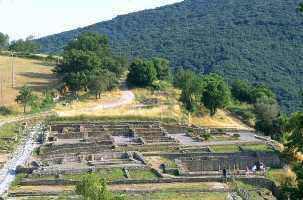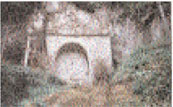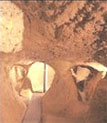
| Weather forecast | Web cam | Weather station | Contact us | Photo Gallery | Links | Search |
| Getting there | Nature | Culture | Epicurean living | Activities | Routes | Our hotel |
| Culture on Monte Amiata |
| Cultural holiday packages |
Etruscans
VETULONIA

The Etruscan City of Vetulonia is located near the entry of the actual village, lied on a hill in Maremma's landscape.
In the necropolis have been discovered many tombs inside white stone circles.
The most important : Tomba della Pietrera, made by two tombs laid one upon the other, Tomba del Diavolino, Tomba Fibula d'Oro, Tomba del Belvedere.
This Etruscan centre represented a long time the most important city of "Metalliferous Hills" mine area.
In the centre of the village has been restored a little museum to learn thoroughly the Etruscan civilization.
It is possible to visit the necropolis from 9 a.m. to 17 p.m.
ROSELLE

The earliest traces of occupation on Roselle go back to the Prehistoric periods, but the organization of the settlement by the Etruscans began by the first half of the 7th century B.C. In the 7th century B.C., the choice of this area for a settlement was due to the large and fertile hinterland suited to agriculture, appropriate for the expectation of control over several lines of communication and to the natural possibility of defence. Among the occasional literary sources on Roselle, it is worth referring to Dionysius of Alicarnassos, who mentions the city together with Chiusi, Arezzo and Volterra, as taking part in supporting the Latins against Tarquinius Priscus at the end of the 7th century B.C. This seems to imply that Roselle was a city of first-rate importance in that period, since it was able to offer military forces as the other wealthy and thriving Etruscan sites, of elder foundation. The archaeological evidence fits this historical context: the remains of the eldest walls of Roselle, with foundations of regular blocks and built of dried clay bricks, date to the 7th century B.C..In the 6th century B.C. the city had a great development: by the last quarter of the 6th century B.C., in fact, Greek pottery imports show that the importance of Roselle was increasingly greatly. The second ring of city walls, built of polygonal blocks of sandstone, dated from the 6th century B.C., run all around both the hills, and it is still visible in extensive parts. At that time, the city was build in clay, terracotta’s and dry-walled stones. The two hills and the intermediate valley were widely urbanized, although they maintained, as we deduce from the archaeological surveys conducted until nowadays their own characteristics: private buildings were on the north hill, while the factories were concentrated on the south hill.The Roman conquest in 294 B.C. by the Consul Lucius Postumius Megellus, is mentioned by Livius. Archaeology does not support this date and the evidence of the first two centuries after the conquest is scant. A destruction layer for fire, datable from the first decades of the First century B.C., suggests that Roselle was involved in the destructions made by Silla, together with other Etruscan cities (Talamone, Vetulonia, Populonia, Volterra and Fiesole).
With the Lex Mlia and the Lex Plautia-Papiria, the inhabitants of Roselle, under Roman domination, were included in the tribe Amensis and they became Roman citizens.
SOVANA
La Necropoli

Sovana is 9 Km far from Pitigliano. The" dimension" of this village is particular, the atmosphere itself is different; it seems to live in another age where time has stopped. Its houses are rich in valuable works which testify the importance of the place in the Middle Age. In the central square there are: the fourteenth century Palazzo Pretorio, the Loggetta del Capitano, Palazzo Bourbon del Monte, the Romanesque church of St. Maria with paintings of the SieneseSchool and a pre-Romanesque ciborium.
At the bottom of the village there is the Duomo, in Romanesque style and a crypt of the 8th century. Near the village the ditches of Folonia and Colesino dug the land for years, giving rise to a high volcanic tuff rock where has been discovered an Etruscan necropolis, as testify the various monumental tombs, some of which can be visited.
If one likes to have sensations, then you have to exceptional emotions and run the Cavone, a road dug in the volcanic tuff.
CHIUSI

Chiusi is likely to have been one of the most important urban centres of Etruria. In vain, the Romans tried to silence its great civilization, whose recollection put the Roman influence in the shade: In vain, they held to cause its end by battles won at the lake of Vladimonio (302.283 BC). Today Chiusi, so rich in discoveries, is likely to take vengeance for time and show its complete life and greatness. Today Chiusi is likely to be the most important town in the ancient discovered Etruria. That is why its history relies rather upon the direct truth of its sprightly and enigmatic Tombs like its gods, objects, paintings and evidence of a complex and civil life than its hazy recollections and legends.It is enough to remember the famous Porsenna King of Chiusi who was likely to help Tarquin the Proud to come to the throne of Rome (520 BC) and his son Arunte who was won by the Romans at Ariccia (506 BC). Tito Livio and Dionysius mention famous Porsenna whose bravery made him be called as "the King of the Etruscans". The Locumonis were probably cultivated and keen on life in its most wonderful forms. Now they lie down on the lids of their sarcophagi, sly and quiet, and leave to us the anxious desire to search, perhaps in vain, their tongue and mystery.We know that in 391 the region was invaded by the Gauls Senoni and that in 296, when Chiusi was already a Roman town, Fabius Maximus was quartered with his troops led by Lucius Scipio the vice-praetor of Etruria. It is doubtful that near Chiusi Silla and Papiro Carbone fought, as mentions an inscription kept in the town. In the Christian age, there were two catacombs: in the III century Chiusi was converted to the Christian religion. The first medieval document of Chiusi consists in a deed of gift of 1191 where Pope Celestine III gave local Bishop Mount Venere. It suggests an Etruscan environment, when going away from Tombe della Scimmia, below Montebello, we find it in front of us at the sun-set with a pine on its top, as if it watched over other sure discoveries. During the wars between Vitige and Belisario (536), as we know by Procopio, Chiusi was a very important stronghold, even all troughs the Longobard period. In these times Regimbaldo, the last Duke of Chiusi as well as brave robber lived and disturbed his neighbour's borders.Among Siena, Perugia and Orvieto, this latter had the possession of Chiusi, whereas in 1231 Siena conquered all the territories of Orvieto and, as a result, also this town. In 1289 the battle between the Ghibellines and Farinata degli Umberti took place near St. Mustiola Bridge. Many times these important towns compete one another the stronghold of Chiusi till 1414. Ladislao King of Naples conquered the whole Val di Chiana. Afterwards, Chiusi was given again to Siena which engraved its coat of arms in the tower of the XII-century stronghold. It rises on a very large Etruscan area full of subways and passages. In 1552 Ascanio della Cornia withdrew the town to Charles V. In 1556 it was under the influence of the Medici. The statutes of Chiusi date back to 1530.In the times of the Medici, the Val di Chiana and outskirt around Chiusi were reclaimed and there was a more and more fast revival of this town. In the last century, since its Tombs were founded, this charming land of Chiusi cannot escape your notice, because it is here that the Etruscan civilization shows itself in a clearer and complete manner than anywhere.